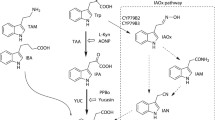Abstract
4-Chlorindole-3-acetic acid (4-CI-IAA), an endogenous auxin in certain plant species of Fabaceae, has a higher efficiency in stimulating cell elongation of grass coleoptiles compared with indole-3-acetic acid (IAA), particularly at low concentrations. However, some investigations reported a 1,000-fold discrepancy between growth stimulation and binding affinity of 4-CI-IAA to auxin-binding protein 1 (ABP1) from maize. Here we report binding data of 4-CI-IAA and three alkylated IAA derivatives using purified ABP1 in equilibrium dialysis. There is a clear correlation between the growth-promoting effects and the binding affinity to ABP1 of the different IAA analogues measured by competition of [3H]naphthalene-1-acetic acid binding. Our data are consistent with the hypothesis that ABP1 mediates auxin-induced cell elongation.
Similar content being viewed by others
Abbreviations
- ABP1:
-
auxin-binding protein 1
- 4-CI-IAA:
-
4-chloroindole-3-acetic acid
- NAA:
-
naphthalene-1-acetic acid
- ER:
-
endoplasmic reticulum
- IAA:
-
indole-3-acetic acid
- 2-Me-IAA:
-
2-methylindole-3-acetic acid
- 4-Me-IAA:
-
4-methylindole-3-acetic acid
- 4-Et-IAA:
-
4-ethylindole-3-acetic acid
- MES:
-
4-morpholineethanesulfonic acid
- PAA:
-
phenylacetic acid
References
Barbier-Brygoo H, Ephritikhine G, Klämbt D, Ghislain M, Guern J (1989) Functional evidence for an auxin receptor at the plasmalemma of tobacco mesophyll protoplasts. Proc Natl Acad Sci USA 86:891–895
Barbier-Brygoo H, Ephritikhine G, Klämbt D, Maurel C, Palme K, Schell J, Guern J (1991) Perception of the auxin signal at the plasma membrane of tobacco mesophyll protoplasts. Plant J 1:83–93
Diekmann W, Venis MA, Robinson DG (1995) Auxins induce clustering of the auxin-binding protein at the surface of maize coleoptile protoplasts. Proc Natl Acad Sci USA 92:3425–3429
Dohrmann U, Hertel R, Kowalik H (1978) Properties of auxin binding sites in different subcellular fractions from maize coleoptiles. Planta 140:97–106
Hertel R (1993) A critical view on proposed hormone action: The example of auxin. In: Smith JC (ed) Biochemical Mechanisms in Plant Growth Regulation. Clarendon Press, Oxford, pp 1–15
Hertel R (1995) Auxin-binding protein 1 is a red herring. J Exp Bot 46:461–462
Hertel R, Thomson KS, Russo VEA (1972) In vitro auxin binding to particulate cell fractions from corn coleoptiles. Planta 107:325–340
Jones AM, Lamerson P, Venis MA (1989) Comparison of site 1 auxin binding and a 22-kilodalton auxin-binding protein in maize. Planta 179:409–413
Löbler M, Klämbt D (1985a) Auxin-binding protein from coleoptile membranes of corn (Zea mays L.). I. Purification by immunological methods and characterization. J Biol Chem 260:9848–9853
Löbler M, Klämbt D (1985b) Auxin-binding protein from coleoptile membranes of corn (Zea mays L.) II. Localization of a putative auxin receptor. J Biol Chem 260:9854–9859
Maddy AH, Dunn MJ, Kelly PG (1972) The characterization of membrane proteins by centrifugation and gel electrophoresis: A comparison of proteins prepared by different methods. Biochim Biophys Acta 288:263–276
Napier RM, Venis MA (1990) Monoclonal antibodies detect an auxin-induced conformational change in the maize auxin-binding protein. Planta 182:313–318
Ray PM (1977) Auxin binding sites of maize coleoptiles are localized on membranes of the endoplasmic reticulum. Plant Physiol 59:594–599
Ray PM, Dohrmann U, Hertel R (1977) Characterization of naphthaleneacetic acid binding to receptor sites on cellular membranes of maize coleoptile tissue. Plant Physiol 59:357–364
Rück A, Palme K, Venis MA, Napier RM, Felle HH (1993) Patchclamp analysis establishes a role for an auxin-binding protein in the auxin stimulation of plasma membrane current in Zea mays protoplasts. Plant J 4:41–46
Shimomura S, Sotobayashi T, Futai M, Fukui T (1986) Purification and properties of an auxin-binding protein from maize shoot membranes. J Biochem 99:1513–1524
Stotz HU, Hertel R (1994) Reevaluation of the role of auxin binding site. II. J Plant Growth Regul 13:79–85
Venis MA, Napier RM, Barbier-Brygoo H, Maurel C, Perrot-Rechenmann C, Guern J (1992) Antibodies to a peptide from the auxin-binding protein have auxin agonist activity. Proc Natl Acad Sci USA 89:7208–7212
Venis MA, Thomas EW, Barbier-Brygoo H, Ephritikhine G, Guern J (1990) Impermeant auxin analogues have auxin activity. Planta 182:232–235
Viola G (1991) Auxin-bindende Proteine aus Mais (Zea mays L.) und Löwenmäulchen (Antirrhinum majus L.) Untersuchungen zur Isolierung und Charakterisierung auf Protein-und Nucleinsäureebene. Dissertation, Universität Bonn
Author information
Authors and Affiliations
Rights and permissions
About this article
Cite this article
Rescher, U., Walther, A., Schiebl, C. et al. In vitro binding affinities of 4-chloro-, 2-methyl-, 4-methyl-, and 4-ethylindoleacetic acid to auxin-binding protein 1 (ABP1) correlate with their growth-stimulating activities. J Plant Growth Regul 15, 1 (1996). https://doi.org/10.1007/BF00213127
Received:
Accepted:
DOI: https://doi.org/10.1007/BF00213127




